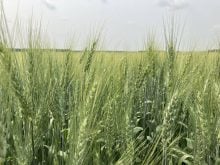Wild buckwheat, polygonum convolvulus, is another of the weeds showing resistance to Group 2 chemicals on the Prairies.
Resistance has been identified in Alberta, but there is a threat across the West due to the widespread presence of the weed and the extensive use of Group 2 herbicides.
Wild buckwheat is an annual, typically producing more than 1,000 seeds per plant, giving it plenty of opportunity for herbicide resistance selection.
Seeds become viable after a few months with most germinating within a year. Research in the 1990s showed that they could persist in the soil for several years.
Read Also

Why feds imposed EV tariffs
Moe and Kinew have a fight on their hands when it comes to eliminating the EV tariff. Canada has to worry about pissing off the U.S. and Mexico and hundreds of thousands of auto workers.
It is a pest in most of the temperate regions.
Where there are no plants to climb for better sunlight exposure, the weed trails along the soil’s surface. It branches at its base, expanding and creating its own canopy until other plants are encountered.
The plant will reach up to one metre in height and has heart-shaped leaves up to 75 millimetres in length with a smooth surface and edge.
The green, milky-coloured flowers appear without petals, but have five conspicuous sepals.
The plant has an extensive, fibrous root system that can chase water and nutrients down to about 80 centi-metres, making the weed competitive with crops and drought tolerant.
As the plant matures, it can be tough to control, but early in the season or when it is small, most crops have an in-crop registered herbicide that will kill it.
At five plants per sq. metre, wild buckwheat can inflict significant yield damage of up to 12 percent in cereals. At 30 plants, those losses reach up to one quarter of the crop’s yield.
In flax, between five and 15 wild buckwheat plants per sq. metre can result in 10 to 20 percent yield losses.
The weed’s ability to climb can also cause crop lodging and create difficult harvesting conditions due to green material in the crop stand.
Due to the appearance of Group 2 resistance in wild buckwheat, tank mixes or combination products that introduce other herbicide groups can be critical to controlling it.
Tillage is effective and rotations that include several years of forage production will also control the plant.
It is also known by the names black bindweed, climbing bindweed and corn bindweed. Until it flowers, it can be confused with field bindweed. The bindweed, another nasty pest, has white petals on its flowers and is perennial.














